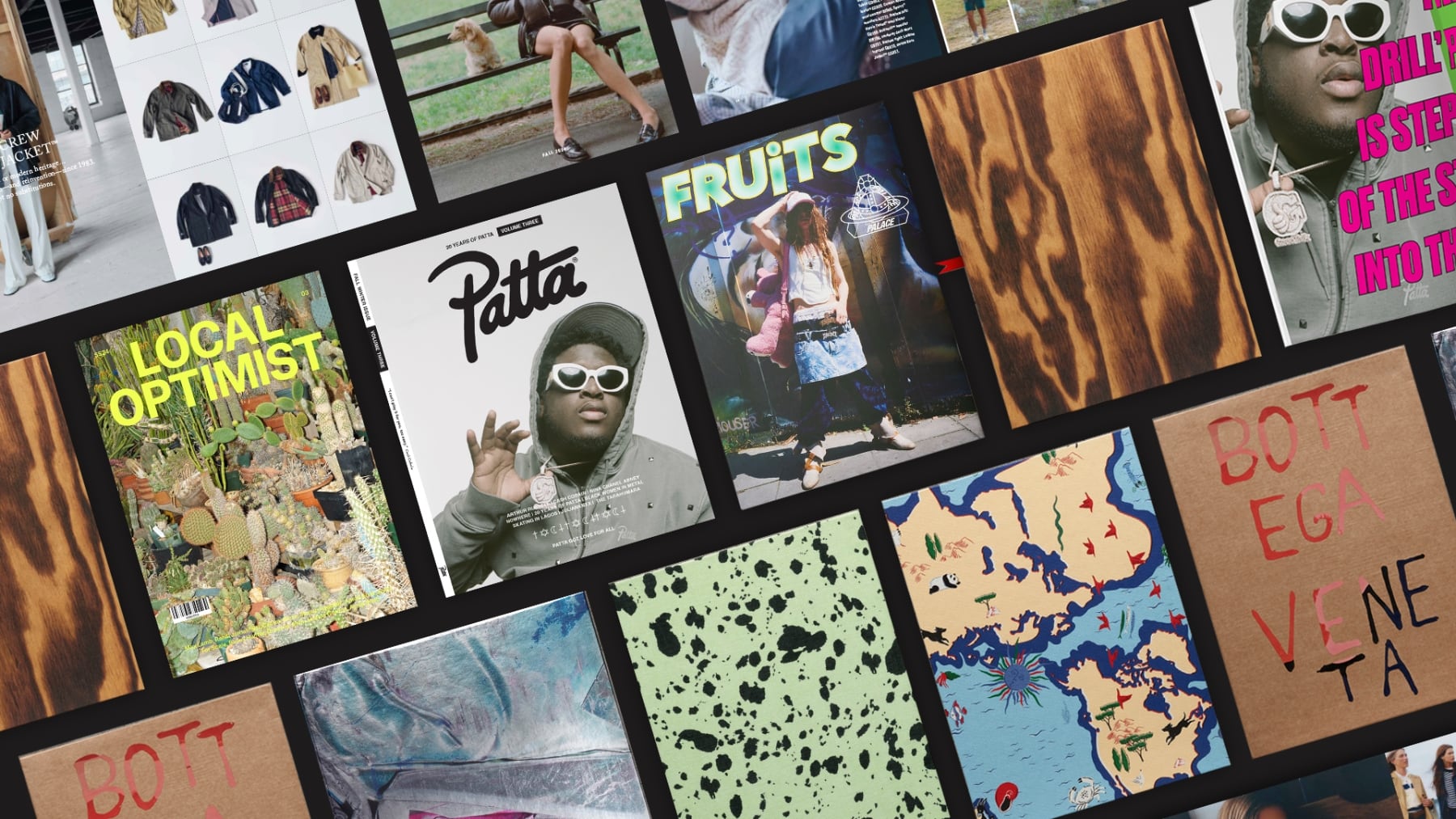
When he’s not designing clothes for Patta, the 20-year-old Dutch streetwear label he co-founded, or working on sneaker collaborations with Nike, Guillaume “Gee” Schmidt still finds himself browsing and buying magazines at newsstands.
Last year, Schmidt, who grew up reading bygone hip-hop periodicals like The Source and glossy fashion magazines like Fantastic Man, decided to try his hand at print himself, launching Patta’s own bi-annual magazine.
“We have so much to tell because we do so many things and due to the nature of the world we live in it’s a challenge to just slow things down,” said Schmidt. “A magazine gives us an opportunity to do so.”
Schmidt isn’t alone in that sentiment. Madhappy also launched its own bi-annual magazine, Local Optimist, last year. In May, Jordan Brand collaborated with the poster-sized street culture magazine Sneeze to print a branded issue dedicated to an archival Air Jordan 1 style. J.Crew returned to print in September when it released its first physical catalogue since discontinuing them in 2017. Even drops by Supreme and Palace this season included print zines for their collaborations with Martine Rose and Vivienne Westwood, respectively.
Not so long ago, print seemed headed for extinction after years of magazines shuttering and media trending towards more video content online. But lately fashion brands have been once again embracing print products as they shift more ad spending offline in an attempt to escape the algorithm and bypass the drawbacks of social-media marketing.
These magazines aren’t solely focused on pushing product but are full editorial efforts, complete with interviews and feature stories that tap into culture while reflecting a brand’s ethos. Perhaps not by accident, they also coincide with a print revival among digital media outlets such as Complex, Spin, Nylon, and Vice, all of which announced a return to print this year.
The author has shared an Instagram Post.You will need to accept and consent to the use of cookies and similar technologies by our third-party partners (including: YouTube, Instagram or Twitter), in order to view embedded content in this article and others you may visit in future.
“We live in a fast paced digital era where everything is condensed into short videos and images specifically for social media consumption,” said Palace’s communications director Patrick Tcherno. “Creating a tangible product that lives on from the cycle of a weekly drop allows for a more meaningful connection and a celebration of the creatives involved.”
These magazines aren’t necessarily easy — or cheap — to put together, however. Meaghan McGovern, editor in chief of Madhappy’s Local Optimist, described it as a “labour of love.”
But done right, they can help brands reach beyond social media and build followings of their own.
World-Building Beyond Instagram
The DTC marketing agency Belardi Wong began noticing an uptick in direct mail print marketing between 2020 and 2021. Since the pandemic, the company has not only seen year-over-year single-digit growth in its direct mail business but also a cultural shift in how fashion brands want to communicate through print, according to co-founder Polly Wong.
“These aren’t your mother’s catalogues,” Wong said, pointing to photography that’s styled more like a PR lookbook. “Instead of having a catalogue with tons of products, it’s more like a glossy fashion magazine.”
Patta’s magazine includes cover stories with rappers like Cash Cobain, as well as editorial features on everything from skateboarding in Lagos to the work of American artist Steve “ESPO” Powers. Editor-in-chief David Kane said Patta decided to lean away from publishing stories about sneakers since its audience is already familiar with the brand through that category. But Kane points out how a feature on the Black European cyclist Dr. Marlon Moncrieffe was “a discreet and elegant” way to promote the Patta cycling team unveiled that same year.
The author has shared an Instagram Post.You will need to accept and consent to the use of cookies and similar technologies by our third-party partners (including: YouTube, Instagram or Twitter), in order to view embedded content in this article and others you may visit in future.
The beauty of a magazine, he said, is that it acts as a snapshot of a moment in time in a way that social media doesn’t while still fueling a brand’s other channels and telling its story.
Similarly, Local Optimist features editorial content inspired by Madhappy’s themes of “connection, tranquillity, and optimism,” with only one page in the back dedicated to the label’s products.
“The mission isn’t to get people to buy Madhappy, it’s to get them to be associated with a good feeling and with this container to be vulnerable with it,” said McGovern. “We’re just trying to be really honest because people are sold to enough.”
What print also offers is marketing with a longer shelf life. Jordan Brand’s special Sneeze issue came together because the magazine’s managing editor, Bradley Carbone, was originally tapped to help conceptualise a video campaign for Jordan. The project evolved into examining the history of the Air Jordan 1 through the lens of the subcultures that Sneeze organically covers, such as skateboarding and graffiti. Carbone said part of the pitch for making a collaborative issue was emphasising how print could extend the campaign’s lifespan.
“On social, you can track the views, impressions and engagement, but it’s all in a very short window,” said Carbone. “Print allows you to be in front of higher-quality eyeballs for a longer amount of time. The downside is it’s less trackable, obviously, but the best campaigns have a mix of the two.”
How Print Reaches Where the Algorithm Can’t
Madhappy and Patta aren’t forgoing social media entirely, like Italian luxury label Bottega Veneta, which left social media in 2021 and launched an online magazine that year. The brand later began producing printed fanzines in 2022.
Wong, in fact, advises her clients to invest in a mixed marketing budget that dedicates 40 percent to digital, 40 percent to print and 20 percent for influencer partnerships and other brand advertising.
But there are advantages print can offer just by virtue of being a physical item. Wong, for instance, finds that her “high-ticket fashion” clients, which include luxury knitwear brand St. John and jewellery label John Hardy, spend as much money on print as they do on digital because print gives them a physically larger space to show off an item like a $1,000 sweater than the tiny window of Instagram on a smartphone.
Patta’s magazine is free and available in Patta stores, but it also places issues at tasteful coffee shops in Amsterdam and the Black Archives, a cultural centre that documents Dutch Black history.
“There’s value in having printed products on the table of a high-quality business or household that likely didn’t exist in the past,” said Sneeze’s Carbone.
In his view, print also lets brands connect with the rising niche audiences looking for content as larger media organisations lose readership. Through Sneeze’s collaborative issue with Jordan Brand, both partners didn’t only reach different groups of consumers but also a concentrated audience that even online algorithms can’t always access.
The author has shared an Instagram Post.You will need to accept and consent to the use of cookies and similar technologies by our third-party partners (including: YouTube, Instagram or Twitter), in order to view embedded content in this article and others you may visit in future.
For Madhappy, part of the appeal of print is the tangibility of the product but also the culture around it. While Madhappy sells Local Optimist in its flagships and online store, it has held release parties at indie bookstores in Los Angeles and trendy Lower East Side clothing stores like Colbo that McGovern said are meant to help build a physical community around the brand.
Emily Huggard, an assistant professor of fashion communication at the Parsons School of Design, pointed out that Gen-Z tends to be very focused on community, and that’s something print publications had in the past. But that’s no longer the case for many media titles.
“I don’t think that GQ reader or Vogue reader is as prevalent anymore. But people do that with brands,” she said.
Print is a medium that comes with challenges, however. Magazines take time and staff to produce. While both Madhappy and Patta said their circulation has grown after the release of each issue, they each framed their magazines more as brand-building efforts than sales drivers. Despite each issue of Local Optimist costing $30, McGovern said revenue isn’t the point so much as getting as many people to read it as possible.
She added that it’s generally “a struggle” to keep brand magazines alive. Every page needs to be fully considered so that it becomes an item that’s kept forever rather than becoming another disposable bathroom read.
In an ideal world, Schmidt envisions releasing new issues of Patta magazine alongside a capsule or new seasonal collection, but true to the nature of a magazine, which asks readers to take a moment to slow down, quality content is prioritised over timing.
“Us doing a magazine means that we can’t do other things,” said Schmidt, pointing out that Patta remains an independent brand. “But it’s very important for culture and for us as a company to bring this into the world.”



